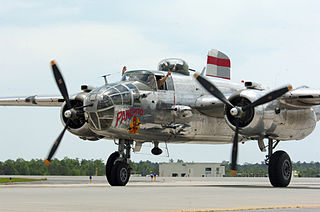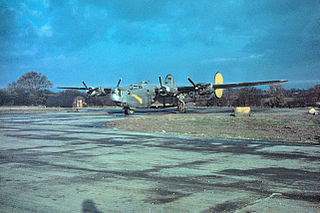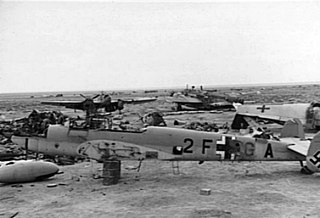
Royal Air Force Aldermaston, or more simply RAF Aldermaston, is a former Royal Air Force station located 8 miles (13 km) east of Newbury, Berkshire and 9.8 miles (15.8 km) southwest of Reading, Berkshire, England.

The Ninth Air Force (Air Forces Central) is a Numbered Air Force of the United States Air Force headquartered at Shaw Air Force Base, South Carolina. It is the Air Force Service Component of United States Central Command (USCENTCOM), a joint Department of Defense combatant command responsible for U.S. security interests in 27 nations that stretch from the Horn of Africa through the Persian Gulf region, into Central Asia.

The 95th Reconnaissance Squadron is a squadron of the United States Air Force. It is assigned to the 55th Operations Group, Air Combat Command, stationed at Offutt Air Force Base, Nebraska. The squadron is equipped with several variants of the Boeing C-135 aircraft equipped for reconnaissance missions.

The 732nd Airlift Squadron, officially 732d Airlift Squadron, is a unit of the United States Air Force. It is part of the 514th Air Mobility Wing at McGuire AFB, New Jersey. It operates McDonnell Douglas C-17 Globemaster III aircraft in providing global strategic airlift to US and allied forces.

The 9th Operations Group is the operational flying component of the 9th Reconnaissance Wing, stationed at Beale Air Force Base, California.

The 559th Flying Training Squadron is an active United States Air Force squadron at Joint Base San Antonio-Randolph, Texas. It operates the Beechcraft T-6 Texan II, and has trained instructor pilots at Randolph since 1972.

The 41st Tactical Group is an inactive United States Air Force unit. Its last assignment was with the 7217th Air Division at Cigli Air Base, Turkey, where it was inactivated in 1970. From 1966 to 1970 the group controlled deployed fighter squadrons.

The 436th Training Squadron is a non-flying training squadron of the United States Air Force. The 436th Training Squadron, located at Dyess Air Force Base, Texas, is a geographically separated unit (GSU) within Air Combat Command’s 552nd Air Control Wing, Tinker AFB, Oklahoma.

The 867th Attack Squadron is an active United States Air Force unit. It was reactivated at Creech Air Force Base, Nevada, on 10 September 2012 as a remotely piloted aircraft squadron.

The 847th Bombardment Squadron is a former United States Army Air Forces unit that was originally activated as the 421st Bombardment Squadron. Its last assignment was with the 489th Bombardment Group at Great Bend Army Air Field, Kansas where it was inactivated on 28 March 1945. As the 20th Antisubmarine Squadron, the squadron performed antisubmarine patrols in 1942 and 1943. After reforming as a heavy bomber squadron, it engaged in the strategic bombing campaign against Germany in the European Theater of Operations until returning to the United States in late 1944. The squadron was inactivated while its parent group was training as a very heavy bombardment unit.

The 12th Operations Group is the flying component of the 12th Flying Training Wing of United States Air Force's Air Education and Training Command. The group headquarters is located at Randolph Air Force Base, Texas.. The unit's main missions include aircraft instructor pilot training in Beechcraft T-6 Texan II, Northrop T-38C Talon and Raytheon T-1 Jayhawk aircraft, Air Force and Navy undergraduate combat systems officer training and fighter fundamentals student pilot instructor training in the Northrop AT-38C.

Dinjan Airfield, also known as Dinjan Air Force Station, is an air base of Indian Air Force. Established as an air field in World War II, it is located in Dinjan, approximately seven miles northeast of Chabua, in the state of Assam, India.

The 94th Operations Group is the flying component of the 94th Airlift Wing, assigned to the United States Air Force Reserve. The group is stationed at Dobbins Air Reserve Base, Georgia.

RAF Gambut is a complex of six abandoned military airfields in Libya, located about 5 kilometres (3 mi) north-northeast of the village of Kambut, and 50 kilometres (31 mi) east-south-east of Tobruk. During World War II, the complex was an important facility, used by the Royal Air Force and many RAF squadrons were temporarily based there.

The 308th Armament Systems Group is a unit of the United States Air Force's 308th Armament Systems Wing, stationed at Eglin Air Force Base, Florida. The group was first activated at Gowen Field, Idaho as the 308th Bombardment Group. It served as a Consolidated B-24 Liberator unit in the China-Burma-India Theater, where it conducted long range bombing missions against Japanese forces, earning a Distinguished Unit Citation. Following V-J Day, it returned to the United States and was inactivated in January 1946.

The 733rd Military Airlift Squadron is an inactive United States Air Force unit. It was activated as the 333rd Bombardment Squadron during World War II. After training in the United States, it deployed to the European Theater of Operations, where it participated in the strategic bombing campaign against Germany, earning a Distinguished Unit Citation. It was inactivated in England following V-E Day.

This is a list of United States Army Air Forces Consolidated B-24 Liberator units and formations during World War II including variants and other historical information. Heavy bomber training organizations primarily under II Bomber Command in the United States and non-combat units are not included.

The 376th Expeditionary Operations Group was a provisional United States Air Force Air Combat Command unit. It was stationed at the Transit Center at Manas International Airport, Kyrgyz Republic, up until 2014.

The 560th Fighter-Day Squadron is an inactive United States Air Force unit. It was last assigned to the 12th Fighter-Day Wing at Bergstrom Air Force Base, Texas, where it was inactivated on 8 January 1958.

The 561st Fighter-Day Squadron is an inactive United States Air Force unit. It was last assigned to the 12th Fighter-Day Wing at Bergstrom Air Force Base, Texas, where it was inactivated on 8 January 1958.





















